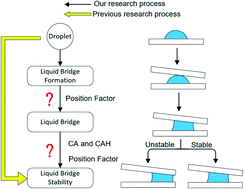Influence of liquid bridge formation process on its stability in nonparallel plates†
Abstract
The formation of a liquid bridge in non-parallel plates is very common and the stability (whether or not it can move spontaneously) of such liquid bridges has been studied a lot for industry, e.g. in printing applications. It is generally considered that the liquid bridge stability is determined by Contact Angle (CA), Contact Angle Hysteresis (CAH), the position of the liquid bridge (represented as P) and the dihedral angle (θ) between non-parallel plates. The stability equation is θ = f(CA, CAH, P). Since P is a process quantity, which is difficult to determine, so it is also difficult to obtain the critical equation for the stability of the liquid bridge. In the previous study (J. Colloid Interface Sci., 2017, 492, 207–217), based on the fitting simulation results, the critical equation about CA, CAH and θ is obtained, as θ = f(CA, CAH). However, in some special cases, the results are still biased (e.g. the weak hydrophilic situation). In this paper, unlike simulation, we get the critical equation θ = f(CA, CAH) from a theoretical point of view. For the first time, by in-depth analysis of the process of liquid bridge formation, the theoretical calculation equation of P is obtained as P = f(CA, CAH, θ). And then, combining the equations θ = f(CA, CAH, P) and P = f(CA, CAH, θ), the theoretical equation is obtained. A lot of simulations and experiments were performed to verify our theoretical equation. Furthermore, comparing our equation with the previous equation, it was found that our equation is more consistent with the experimental results (error less than 0.2°). Finally, the importance of considering the liquid bridging process (the function of P) for stability analysis is illustrated by comparing the results with those not considered (the difference is more than 20% in some cases). The outputs of this paper provide in-depth theoretical support for the analysis and application of liquid bridges.



 Please wait while we load your content...
Please wait while we load your content...